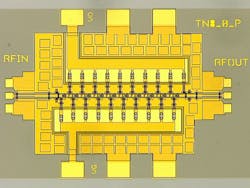Terahertz chip offers new applications in sensors, communications, and collision avoidance
Developed on behalf of the U.S. Defense Advanced Research Projects Agency (DARPA) in Arlington, Va., the circuit is the culmination of the company's three-phase contract with the agency to demonstrate transistor-based electronics operating at 670 gigahertz, 850 gigahertz, and 1 terahertz, company officials say.
Terahertz is a slice of the electromagnetic spectrum that lies between microwaves and infrared light waves. Researchers have long sought to exploit this tremendously high-frequency band, commonly referred to as the "terahertz gap," but have been unable to detect, process, and radiate the necessary high-frequency signals without resorting to frequency translation or multiplication, company officials say.
Related: RF and microwave technology enable networking on the move
The TMIC bridges this gap by using a super-scaled 25 nanometer gatelength indium phosphide high electron mobility transistor that measures at a gain of 10 decibels at 1 terahertz and nine decibels at 1.03 terahertz. In comparison, present day smartphones operate at 1 to 2 gigahertz and wireless networks at 5.7 gigahertz.
"This breakthrough by the Northrop Grumman team could lead to revolutionary technologies such as high-resolution security imaging systems, improved collision-avoidance radar, communications networks with many times the capacity of current systems and spectrometers that could detect potentially dangerous chemicals and explosives with much greater sensitivity," says Dev Palmer, program manager at the DARPA Microsystems Technology Office.
Additional applications could include atmospheric sensing, radio astronomy and medical imaging. It also is expected to improve system range, and reduce size, weight and power consumption of existing systems.
Related: DARPA creates solid state receiver that operates at 0.85 terahertz
Northrop Grumman officials claim their company's TMIC technology is the foundation of the world's fastest integrated circuit amplifier, which uses 0 transistor stages to reach an operating speed of one terahertz (1012 Hz), or one trillion cycles per second.
DARPA scientists have promoted terahertz electronics through the agency's High Frequency Integrated Vacuum Electronics (HiFIVE), Sub-millimeter Wave Imaging Focal Plane Technology (SWIFT), and Technology for Frequency Agile Digitally Synthesized Transmitters (TFAST) programs.
For more information contact Northrop Grumman Aerospace Systems online at www.northropgrumman.com, or DARPA at www.darpa.mil.
